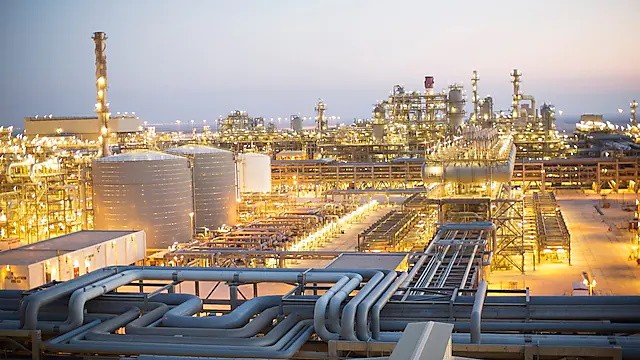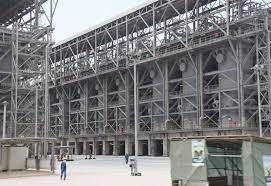An article written while I worked at Zeton may be instructive in relation to this topic as a backgrounder:
https://www.linkedin.com/pulse/scaling-up-down-paul-martin/
Once we reach a certain maximum practical vertical scale for a particular piece of equipment, it becomes impractical to build a bigger unit, or to transport and erect it once it’s built, as noted in the previous article. At that point, we shed a few tears, because we know that the continually decreasing capital cost per unit of value created is now more or less over for that unit. But generally, this is not encountered in every unit on a plant at the same scale. When we’ve got the largest pump, filter, reactor etc. that can be made in practical terms, the next step isn’t to build two complete twin plants on the same site, much less two complete plants on two different sites to save on distribution. Rather, we will usually “number up” the largest practical thing, running several of them in parallel.
Sometimes we do that even though we’re below the maximum practical scale. Some plants have “trains” of duplicated units which run in parallel, such that one train can be shut down for maintenance, or because the market dries up. Common infrastructure is maintained, and that gives us some of the benefit of vertical scale- just not to the same extent as if we made each unit bigger.
An example is the Shell Pearl GTL project pictured in the 1st article.

(Shell Pearl GTL- a mammoth gas to liquids plant installed in Qatar- photo credit, Shell)
That project produces liquid hydrocarbons ranging from LPG to waxes, starting with fossil gas. The process, known as Fischer Tropsch, takes CH4 apart to CO and H2 (and lots of CO2) and then back-hydrogenates CO to -CH2- and H2O. It is so inefficient, as a result of wasting all that hydrogen “un-burning” CO to make water, that the only way it can make money is:
- You must do it at positively mammoth scale to drop the marginal capital cost of the overall plant to the lowest practical level
- You must pair it with a gas source which is both enormous and basically free
- You must be able to dispose of fossil CO2 to the atmosphere, again basically for free
Accordingly Pearl GTL is positively mammoth- it must be to make money for its owners, at prices of products that the market are willing to pay. Capital cost was on the order of $20 billion.
It is in fact so huge that it “numbers up” its reactors.
Each reactor is a giant pressure vessel- weighing 1,200 tonnes- containing 29,000 catalyst tubes in a common shell from which the heat is removed. Each reactor is as big as Shell could make them, without what Shell considered to be excessive “heroics”.
There are two trains of reactors. And in each train, there are 12 reactors operating in physical parallel.

Shell Pearl’s reactors, installed. Photo Credit www.oilandgasmideast.com
This is basically an object lesson in “numbering up”. Each catalyst tube is as big as it can be without making the wrong products. As many such tubes are put into a single pressure vessel as practical, to make the cost of physical paralleling of these tubes as low as practical. And then, large numbers of these pressure vessels are installed again in physical parallel, arranged in trains.
The rest of the plant is similarly divided up into single or multiple units in accordance with the maximum practical scale at which the process itself can be carried out. If I recall correctly, it has two of the largest air separation plants ever built, a huge autothermal reformer etc.
Shell didn’t pursue this giant scale for fun and games. Apparently they looked at this project numerous times over more than a decade, before deciding to pursue it. They ran the numbers and convinced themselves, quite correctly, that the only way to make money from Fischer Tropsch, even with a nearly free gas supply, is to go big- so big in fact that numbering up the reactors was the only practical option.
“Numbering Up” to Minimize Scale-Up Risk
There’s another reason some people give for pursuing a “numbering up” rather than scaling up strategy. Sometimes, making the bigger unit with higher production capacity is easy- but sometimes, it’s very risky indeed. The larger unit we design might not work at all, or might make a different product, or undesired byproducts etc.- even if you retain experts to help you make the best stab at building the larger unit that you can. The risk here isn’t just money, it’s time. A development project for a larger unit, can take considerable time. And if customers are knocking down your door already today, you may not want to wait. Under those circumstances, numbering up small units which have already been proven to work, seems a tempting option.
The Downsides of Numbering Up
Unfortunately, for every unit we have to run in physical parallel (because we had to number up rather than scaling up), we now have multiple devices to procure, install, connect, control and test. That means more valves, more switches, more wires, more instruments and controls, more installation labour, quality control, testing etc.- and more cost. It also means more likelihood of an individual failure of some kind, even though the failure of one unit might only reduce production by a small amount of the total (that’s an advantage of numbering up in “trains” as noted above).
If making a larger unit is possible, even with some risk, it’s likely worth doing- if the market can support that much product. What we are unlikely to get away with is to instead build multiple identical smaller units and operate them in physical parallel- especially if the individual units are a small fraction of the total production that the larger plant could produce.
Of course if we take “numbering up” or “horizontal scale” to its logical conclusion, we see some of the many things we use on a daily basis- articles that are mass produced in plants which themselves take advantage of as much vertical scale as possible, so that each commodity product item (computer, solar panel, car etc.) itself is as cheap as it can be.
This is where the proponents of certain schemes, fall into the ditch. They frequently confuse the apparatus making the commodity goods, with the commodity goods themselves!
Why “Mass Production” – of the Means of Production- Can’t Win
But surely if we mass-produce entire plants to make our commodity, those plants will get cheaper and their capital cost per unit of production will drop?
No, they won’t. Because S^0.6 is an exponential function. It positively destroys any benefit which mass production of the plant itself could possibly generate.
Furthermore, the sorts of things we’re talking about here aren’t suitable to true mass production.
Modular Construction
Sure, you can build a complete chemical plant in a factory, in pieces of a size and weight suitable to be shipped by whatever means you like. Such construction is referred to as “modular”, and I was in the business of designing and building small modular chemical plants used as pilot and demonstration and small commercial units for over two decades. Modular construction offers many advantages- faster schedule, better build quality, and higher labour productivity among others, when it’s done right.
https://www.linkedin.com/pulse/designbuild-approach-modular-construction-paul-martin/
And despite this, I can say, unequivocally, on the basis of that considerable experience, that nobody would ever achieve lower cost per unit of production by getting ten modular plants of identical design, built at the same time as modular projects, if building a 10x larger plant on site (referred to as a “stick built” rather than modular plant) was a practical alternative. Whereas a modular design/build operation might be able to offer ten plants of unit cost 1 for 10^0.9 = ~ 8.1x the cost of the first one, the 10x larger plant- including the extra cost associated with “stick building” the parts of it that were too big to modularize, would cost only 10^0.6 = 4x. These figures are, of course, very rough, but they give you the basic idea.
If you want real mass production, order 10,000 of them at the same time…but how likely are you to do that?
Where Horizontal Scale is Your Only Choice
The first article in this series examined the conditions under which the economy of vertical scale was valid. If any of those conditions are violated, horizontal scale may be your only choice.
If your product is unstable, i.e. ozone, you have no choice but to put an ozone generator on every site that needs ozone. That those ozone generators are mass produced, however, does not make ozone a cheap chemical! Its cost is high not just because it is energy inefficient to make, but also because the need to make it on site in tiny ozone plants makes inefficient use of capital, even though the ozone units themselves are built in factories. That inefficiently used capital cost makes every kg of ozone that much more expensive.
If your feed or product can’t be distributed readily, you may also have no choice but to go for horizontal scaling, on separate sites. Of course that is no guarantee whatsoever that the resulting product, made using equipment with poor capital utilization efficiency (high marginal capital cost), is worth enough to make the enterprise into a business.
And no, “mass production” of the necessary plant equipment, absolutely won’t save you.
In the next articles we’ll use these concepts to evaluate a number of claims in the renewable/alternative energy world, to see whether or not they make sense.
